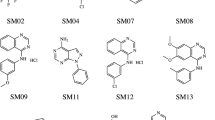Summary
Neural networks and inductive logic programming (ILP) have been compared to linear regression for modelling the QSAR of the inhibition of E. coli dihydrofolate reductase (DHFR) by 2,4-diamino-5-(substitured benzyl)pyrimidines, and, in the subsequent paper [Hirst, J.D., King, R.D. and Sternberg, M.J.E., J. Comput.-Aided Mol. Design, 8 (1994) 421], the inhibition of rodent DHFR by 2,4-diamino-6,6-dimethyl-5-phenyl-dihydrotriazines. Cross-validation trials provide a statistically rigorous assessment of the predictive capabilities of the methods, with training and testing data selected randomly and all the methods developed using identical training data. For the ILP analysis, molecules are represented by attributes other than Hansch parameters. Neural networks and ILP perform better than linear regression using the attribute representation, but the difference is not statistically significant. The major benefit from the ILP analysis is the formulation of understandable rules relating the activity of the inhibitors to their chemical structure.
Similar content being viewed by others
References
Hansch, C., Maloney, P.P., Fujita, T. and Muir, R.M., Nature, 194 (1962) 178.
Hansch, C., Acc. Chem. Res., 2 (1969) 232.
So, S.-S. and Richards, W.G., J. Med. Chem., 35 (1992) 3201.
Andrea, T.A. and Kalayeh, H., J. Med. Chem., 34 (1991) 2824.
Aoyama, T., Suzuki, Y. and Ichikawa, H., J. Med. Chem., 33 (1990) 905.
Aoyama, T. and Ichikawa, H., J. Chem. Inf. Comput. Sic., 32 (1992) 492.
Tetko, I.V., Luik, A.I. and Poda, G.I., J. Med. Chem., 36 (1993) 811.
King, R.D., Muggleton, S., Lewis, R.A. and Sternberg, M.J.E., Proc. Natl. Acad. Sci. USA, 89 (1992) 11322.
Hirst, J.D., King, R.D. and Sternberg, M.J.E., J. Comput.-Aided Mol. Design, 8 (1994) 421.
Li, R.L., Hansch, C. and Kaufman, B.T., J. Med. Chem., 25 (1982) 435.
Champness, J.N., Stammers, D.K. and Beddell, C.R., FEBS Lett., 199 (1986) 61.
Matthews, D.A., Bolin, J.T., Burridge, J.M., Filman, D.J., Volz, K.W., Kaufman, B.T., Beddell, C.R., Champness, J.N., Stammers, D.K. and Kraut, J., J. Biol. Chem., 260 (1985) 381.
Selassie, C.D., Li, R.-L., Poe, M. and Hansch, C., J. Med. Chem., 34 (1991) 46.
Hansch, C., Li, R.-I., Blaney, J.M. and Langridge, R., J. Med. Chem., 25 (1982) 777.
Li, R.-L. and Poe, M., J. Med. Chem., 31 (1988) 366.
Dietrich, S.W., Blaney, J.M., Reynolds, M.A., Jow, P.Y.C. and Hansch, C., J. Med. Chem., 23 (1980) 1205.
Roth, B., Aig, E., Rauckman, B.S., Srelitz, J.Z., Phillips, A.P., Ferone, R., Bushby, S.R.M. and Siegel, C.W., J. Med. Chem., 24 (1981) 933.
Roth, B., Rauckman, B.S., Ferone, R., Baccanari, D.P., Champness, J.N. and Hyde, R.M., J. Med. Chem., 30 (1987) 348.
Leo, A., Hansch, C. and Elkins, D., Chem. Rev., 71 (1971) 525.
Muggleton, S. and Feng, C., In Arikawa, S., Goto, S., Ohsuga, S. and Yokomori, T. (Eds.) Proceedings of the First Conference on Algorithmic Learning Theory, Japanese Society of Artificial Intelligence, Ohmsha Press, Tokyo, 1990, pp. 368–381.
Minitab, release 7.2, VAX/VMS version, Minitab, Inc., Pensylvania State University, Philadelphia, PA, 1989.
Rumelhart, D.E., Hinton, G.E. and Williams, R.J., Nature, 323 (1986) 533.
Owens, A.J. and Filkin, D.L., In IEEE/INNS International Joint Conference of Neural Networks, Washington, DC, 1989, pp. 381–386.
Gear, C.W., Numerical Initial Value Problems in Ordinary Differential Equations, Prentice Hall, Englewood Cliffs, NJ, 1971.
Livingstone, D.J. and Salt, D.W., Bioorg. Med. Chem. Lett., 2 (1992) 213.
Livingstone, D.J. and Mallanack, D.T., J. Med. Chem., 36 (1993) 1295.
DeLong, H., A Profile of Mathematical Logic, Addison-Wesley, Reading, MA, 1970.
David, H.A., Biometrika, 74 (1987) 432.
Muggleton, S., Srinivasan, A. and Bain, M., In Sleeman, D. and Edwards, P. (Eds.) Proceedings of the 9th International Conference on Machine Learning, Morgan-Kaufman, San Mateo, CA, 1992, pp. 338–347.
Kendall, M. and Stuart, A., The Advanced Theory of Statistics, Griffen, London, 1977.
Press, W.H., Teukolsky, S.A., Vettering, W.T. and Flannery, B.P., Numerical Recipes, Cambridge University Press, Cambridge, 1992.
Author information
Authors and Affiliations
Rights and permissions
About this article
Cite this article
Hirst, J.D., King, R.D. & Sternberg, M.J.E. Quantitative structure-activity relationships by neural networks and inductive logic programming. I. The inhibition of dihydrofolate reductase by pyrimidines. J Computer-Aided Mol Des 8, 405–420 (1994). https://doi.org/10.1007/BF00125375
Received:
Accepted:
Issue Date:
DOI: https://doi.org/10.1007/BF00125375



